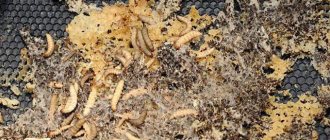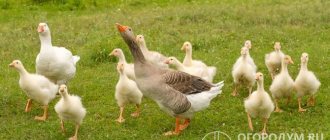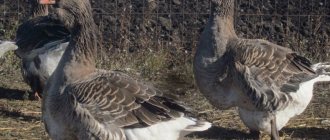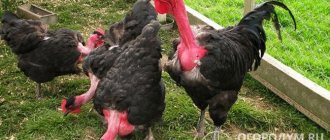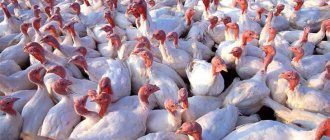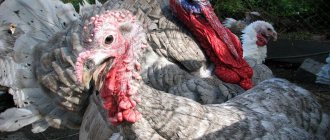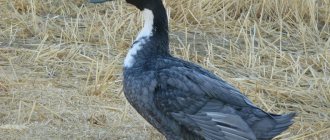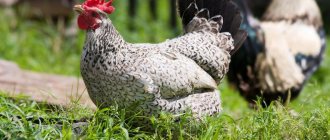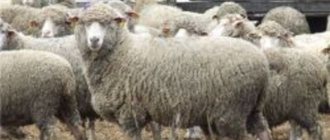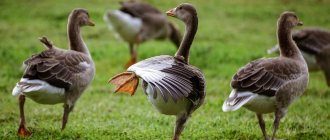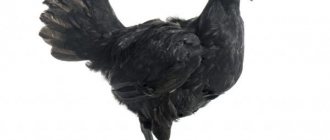The Danish Legart breed of geese is just gaining popularity among poultry farmers in our country. It is distinguished by high quality and taste of meat, gains weight well and quickly, and consumes less feed compared to other breeds. Features of keeping, feeding and breeding Danish Legart geese are discussed in this article.
Origin story
From the name itself you can recognize the country of origin of these geese - Denmark. The breed was obtained by crossing many breeds in order to obtain birds with excellent productivity indicators, high weight with an average build and minimal maintenance costs.
These geese arrived in our country not so long ago and are just beginning to become widespread.
The correct name for the breed is Danish Legart, although they are often called Danish Legard.
Caring for young animals
To raise Danish Legard geese to slaughter age, a standard poultry house is suitable, in which they will remain until slaughter. It should be warm, spacious, bright and well ventilated (for ventilation, you can use vents in the windows that need to be opened periodically, or install a ventilation system in the room). All cracks must be sealed to prevent drafts and dampness.
Next to the poultry house you need to make a small pen in which the bird will walk and rest. Place containers with water, small pebbles and sand in it. If there is a meadow or pond nearby, then you can drive the geese there.
Description and characteristics of the breed
The breed is considered one of the best in the world. Let's look at its main characteristics in more detail.
Table of the main characteristics of the Danish Legart breed:
| Goose | Goose | Egg production, eggs/year | Egg weight, g | Hatching instinct | Egg fertilization, % | Survival rate of goslings, % | Down yield, kg/year per individual | ||
| Weight, kg | Puberty, days | Weight, kg | Puberty, days | ||||||
| 7-8 | 270-280 | 6-7 | 260-270 | 33-40 | 150-200 | absent | 60-65 | 70-80 | 0,3-0,5 |
Appearance
The appearance of an adult bird can be described:
- plumage – snow-white, without inclusions;
- the body is more square in males, elongated in females, the seat is deep;
- back – straight and wide;
- belly – has a shallow fold of fat;
- legs – yellow to orange, metatarsus – long;
- neck – not very long, thick, curved;
- head – small, oblong;
- the beak is yellow-orange, small, and has a white bulge at the end;
- eyes – a feature of the breed is blue eyes;
- the bones are not wide, graceful.
Appearance of the goslings:
- the first brood has a yellow downy coat with dark spots;
- subsequent generations have yellow pubescence without inclusions;
- after the first molt, the cover of both broods acquires a snow-white color without inclusions.
Character
The character of birds can be described:
- peace-loving, calm and balanced birds;
- not aggressive, do not attack other residents of the poultry yard, strangers, children, do not start fights among themselves;
- get used to the owner in a short time, respond to commands;
- they don't make noise.
They may show dissatisfaction during the nesting period.
Laying period and average annual egg production
On average, sexual maturity occurs at 270 days. In females this process occurs several weeks earlier than males. During this period they begin to lay eggs.
Annual productivity is up to 40 eggs weighing 200 g each, which is considered high. But at the same time, their fertilization rate is no more than 65%.
You can read about goose egg laying in more detail separately in our other article.
Individual weight and meat productivity
The breed is mainly bred for meat. In adulthood, the male reaches a weight of 8 kg, the female - 7 kg.
The bird is early ripening. According to the stated characteristics, the chicks weigh about 6 kg already at 8-10 weeks. And a month later – 7 kg.
Owners of the Danish Legart breed consider such figures to be somewhat exaggerated; according to them, a weight of 5 kg can be expected by 4-5 months from birth.
Accelerated weight gain in geese by 2-4 months is considered by poultry farmers to be a publicity stunt.
Goose meat is considered dietary. It is gentle and has a small percentage of connective tissue, so it is easily absorbed. Fat deposits do not affect the quality, as they are located under the skin.
The tasty, fatty liver of these geese is highly valued, which, with good feeding, can reach a weight of 500 g or more.
Down productivity
Danish Legart geese are distinguished by high levels of down quality. You can start pinching it from the 11th month of the bird’s life.
Regular plucking is carried out every 6 weeks. In a year you can get up to 0.5 kg of fluff from one bird.
Puberty, which determines the quality of the offspring
Female Danish geese become ready to mate at 8-9 months. From this period until 3 years of age, the egg production of geese increases annually by 20% and is stable until 5-6 years. Later the numbers drop. Therefore, females over 6 years old are not kept on farms.
Puberty in ganders occurs 3 weeks later than in geese. During this period, the female brings fewer fertilized eggs. In this regard, the first clutch is removed so that the next goose can lay full eggs.
The male has a greater influence on the fertility of eggs and the quality of the offspring than the female. The gander's best performance characteristics develop between 2 and 4 years of age. Therefore, ganders are kept on the farm for no longer than 4 years.
To reproduce the herd, a strong, large gander is selected. If a male loses weight during the breeding season, he is fed.
With related breeding, the viability of the offspring decreases. If a gander is replaced, it is selected from another farm.
Content Features
Danish Legart geese are easy to care for; they grow quickly without causing any trouble for the poultry farmer. It is important to observe only a few important nuances.
Premises requirements
Geese are heat-loving birds. When arranging a poultry house, it is necessary to exclude the occurrence of any drafts and the ingress of natural precipitation. During the cold season, the floor and walls are insulated, for example, with wood materials.
The goose barn is built on a hill, preferably next to a walking yard and access to a reservoir.
The poultry house must be equipped with:
- Thick walls . Their thickness is at least 20-25 cm. Brick, foam blocks, cinder blocks, and wood are suitable materials. The height of the walls is 2 m.
- Roof . Make it from tiles, slate or roofing felt. The constructed attic will serve as additional thermal insulation, both in summer and winter.
- Floor . Make it out of wood, concrete, or leave it earthen.
- Zone separator . Create 2 zones in total: for adults;
- for young animals. Each zone should have a separate place for eating and sleeping at night.
- Nests. Install them at the rate of 1 nest per 2 geese in a shaded area, away from the entrance, preferably on the south side.
- Feeders. Installed in the poultry house. You can set up a separate “room” for eating.
- Drinking bowls. Must always be freely available.
- Bedding. Suitable materials include straw, sawdust, sand, dry grass, and peat. Layer thickness – at least 10 cm.
- Ventilation. High-quality ventilation of the room is necessary. The best option is ridge ventilation.
- Windows. Which should occupy up to 20% of the walls of the goose barn. Be sure to insulate them for the winter.
- Additional lighting. It is necessary during the breeding season to extend daylight hours to 14 hours. Install 1 60 W lamp on an area of 6 square meters. m.
The gooseneck must support:
- Area per 1 individual. Geese do not like crowded spaces; one bird needs 1 sq. m area. As a last resort, you can keep 2 individuals per 1 square. m. Crowding provokes a decrease in weight and egg production, and a deterioration in the quality of fluff.
- Temperature regime. The optimal temperature will be 22-26 °C.
Install additional heating if the geese get cold in winter.
- Humidity. 50-60 %.
Walking yard
You can't keep a bird locked up all the time. She needs a walk.
For these purposes, a corral will be equipped:
- Space. Should be sufficient for free movement of geese. The ideal option is 10 sq. m per individual. The best place will be the south side of the poultry house.
- Fencing. Use mesh or build a wooden fence.
- Canopy. Install the canopy in a place protected from the wind, where geese, especially young ones, can hide from the sun and precipitation.
- Coating. Geese love to graze, so plant your walking yard with forbs. Eating green cereals will also be beneficial.
In winter, before releasing the geese into the yard, you need to clear it of snow.
If it is impossible to provide free range on the farm, take the herd to the meadow for grazing for the whole day.
In summer, geese can stay outside 24 hours a day, provided they have a canopy.
Access to water
Geese are waterfowl; they need access to water, be it an artificial pond in a walking yard or a river/pond in a meadow.
According to scientists, the lack of water does not reduce either egg production or weight gain. But, the importance of free access to water is that it is a natural environment for mating.
The fertilization of eggs increases with the possibility of mating in water bodies.
Feeders and drinkers
The number of feeders is calculated: 1 pc. for 10 geese or 15 cm of sidewall for 1 individual.
There should be 3 containers:
- For wet mash. Possibly made of metal.
- For dry food. You can use plywood boxes.
- For mineral supplements.
Fermented milk products should not be served in metal containers.
Drinkers are installed at the rate of 1 piece. 2 m long for 10 heads. You can use a plastic pipe with the top cut off. Change the water in them up to 3 times a day. In winter, add warm water and do not allow it to freeze.
Disease Prevention
Preventive measures for common diseases of geese include following the rules of care:
- Hypothermia and overheating. In summer, the temperature in the poultry house should not be allowed to rise above 30, and in winter below 0 °C.
- Humidity in the room. With low humidity, geese's mucous membranes and eyes may become inflamed, and their feathers may dry out. With elevated levels, the risk of developing fungal and bacterial diseases increases.
- Disinfection. After completion of construction, treat the walls and floor with lime. Next, disinfect once a month using a solution of lime, formaldehyde or copper sulfate. After the procedure, ventilate the house for 2 hours.
- Regular cleaning and changing of bedding. If this rule is not followed, the likelihood of parasitic infestations is high.
- Cleanliness of feeders and drinkers. Clean feeders and drinkers regularly. Change the water promptly; throw away uneaten food, especially wet food.
- Fresh air. If there is no ventilation in the goose barn, there is a risk of fungal plaque developing on the walls.
- Protection from overheating in the sun. Both adults and goslings do not do well in direct sunlight.
- Vaccinations. In order to preserve the number of geese, it is imperative that they receive the necessary vaccinations.
Danish Legart geese are difficult to treat, sometimes it is not possible, so compliance with preventive measures is mandatory.
It is recommended to nurse weakened young animals:
- Milk-yolk mash. Chicken yolk is diluted in 0.5 cups of fresh, full-fat milk. Add sugar, biomycin or penicillin to the mixture. Helps with exhaustion of the body. Feed until recovery.
- Maintaining room temperature. It should be at +23 °C.
- Exercise. In sunny, windless weather, let them go for walks for 10 minutes.
You can read more about goose diseases, their varieties and characteristics here.
Feeding
The diet will depend on the age of the bird and the time of year.
In summer and winter
In the summer, while grazing, geese consume up to 1-2 kg of fresh grass per day, so they do not need intensive feeding at home. In the evening they can be offered grain feed.
During the winter, you should take care of quality nutrition, which should consist of:
- Forb hay . Alfalfa, clover, wheatgrass.
- Vegetables. Beets and carrots - to maintain normal weight. Jerusalem artichoke - to increase immunity and frost resistance.
- Grain. Keep in mind that the diet cannot consist exclusively of grains. Their percentage is 30-40.
- Mineral and vitamin supplements. Chalk, sand, fine gravel, shell rock, and salt are given as mineral supplements. To prevent the development of vitamin deficiency, add up to 20 g of yeast feed per day.
You can also include in your diet:
- bran;
- dry feed with rowan, viburnum, rose hips, hawthorn;
- foliage and thin branches of birch, aspen, linden, acorns, pine needles, aquatic plants;
- earthworms, which can be grown in containers with manure and kept in the basement in containers with soil.
Feed the bird at least 3 times a day. The evening dose is increased several times. Supplement your evening meal with food high in fiber (bran, grass meal).
The need for clean water is determined by the formula - for 1 kg of dry food - 4 liters of water per individual.
Table of the required amount of feed per 1 bird for the winter period:
| Name of food | Consumption, kg |
| Hay | 20 |
| Beet | 30 |
| Carrot | 30 |
| Jerusalem artichoke | 30 |
Adult birds and young animals
Depending on the age of the bird, the change in diet is indicated in the table.
Table of diet of geese depending on age:
| Age, days | Dry food, g/day | Green feed, g/day |
| 1-6 | 15 | 25 |
| 7-20 | 40 | 90 |
| 21-30 | 100 | 180 |
| 31-40 | 120 | 260 |
| 41-50 | 140 | 350 |
| 50 and adults | 160 | 500 |
Productivity indicators
The Danish breed of geese has a high level of nastiness while using less grain feed. Young animals at the age of 2 months, eating only grass, can gain up to 6 kg of weight. Birds at 3 months weigh up to 7 kg. For faster weight gain, experienced farmers recommend feeding birds with a grain mixture and mixed feed.
Meat of this breed is in high demand due to its taste , high nutritional level and low fat content. The bulk of fat deposits is located under the skin and does not mix with meat fibers. The meat product contains vitamins A, B, PP, C, as well as a large number of mineral components.
Goose liver is no less in demand, the weight of which can reach up to 800 grams. One goose is capable of producing offspring that will produce about 100 kg of high-quality and healthy meat. Not only goose meat products are highly popular and in demand, but also down.
One one-year-old bird can produce up to 1000 grams of high-quality downy raw material per year. Partial plucking of adults can be done every 2 months. Experienced farmers use not only the meat and down of geese for sale, but also their droppings, which have a high nitrogen content and are in high demand among gardeners and summer residents.
Breeding
Since ganders mature more slowly than geese, in the case of the first laying of eggs by birds of the same age category, it is better to remove it in order to provoke the females to lay eggs again.
Females begin laying eggs in April.
If the flock consists of young geese and an old goose, the eggs will be fertilized from the first clutch.
Female Danish Legarts do not have the brooding instinct, so the goslings must be hatched in an incubator.
While you collect the required amount, store fresh eggs following these recommendations:
- temperature should be 10-15 °C;
- lay the eggs on their side;
- You can store the egg for incubation for no longer than 1 week, then the chances of successful hatching of the goslings decrease;
- On the 5th day of storage, turn the eggs on the other side, this way there is a better chance of preserving the embryo.
Criteria for selecting eggs for incubation:
- size – large or medium;
- clean;
- surface – smooth, without growths, without cracks;
- when checking with an ovoscope, the yolk spot is clearly visible, it is evenly located in the center, when turning it returns to its place, there are no inclusions in the white.
Temperature and humidity in the incubator
After laying the eggs in the incubator, set the temperature at +38.0...+38.5 °C, humidity 80%. Next, change the indicators in accordance with the data in the table.
Table of temperature and humidity in the incubator by day:
| Period, day | Temperature, °C | Humidity, % | Cooling, once/day |
| 1 | 38,0-38,5 | 80 | – |
| 2-8 | 37,5-38,0 | 65 | 1 |
| 9-29 | 37,0-37,5 | 65 | 2 for 15-30 min. |
| 29-31 | 37,0-37,5 | 80 | – |
Incubation and hatching of eggs
Process and sequence of egg incubation:
- place the eggs in the incubator on their side;
- for the first 7 days, turn the eggs 5 times a day daily;
- in the first 7 days, spray the eggs;
- from 7 to 14, take a break from spraying;
- from the second week, turn the eggs at regular intervals 3 times a day;
- on day 10, make the first culling of eggs, checking them with an ovoscope;
- from day 15, start spraying the eggs again;
- 21 days cull again;
- from day 26, stop turning the eggs;
- Day 28: remove the eggs from the incubator for ventilation and sprinkle them with a solution of potassium permanganate;
- Every 6 hours, moisten the eggs or cover them with a damp cloth;
- place a cloth in the incubator to prevent the chicks from damaging their legs when hatching;
- open the vents on the incubator lid.
The hatchability of goslings, if all the rules are followed, is 80%.
The exact time of hatching is impossible to predict. This usually occurs between 28 and 31 days.
Caring for young animals
Caring for young animals involves maintaining cleanliness and rational feeding.
The room where the goslings are kept should always be clean, feeders and drinkers should be washed and disinfected, and fresh water should be freely available.
Food should not be left for later; always cook it before use and throw away any leftovers.
At the age of 3 weeks, the goslings are released for their first walk. To do this, set aside a special area, taking care of their safety.
At this time, they stop feeding the chicks so that they themselves learn to eat greens. When they begin to receive most of their diet from plants on the range, you can again introduce additional feeding from crushed grain or mixed feed.
Feeding goslings depending on age:
- First day. After hatching and drying, the chicks are immediately offered food. This helps remove the yolk from the body, causing the chicks to grow faster and reduce the risk of mortality. The diet consists of: boiled eggs, previously finely chopped;
- ground grain;
- corn grits;
- fresh greens, which should make up 50% of the total diet. Goslings are fed every 3-4 hours (about 8 hours a day). Feed is given in a tray or on a plywood sheet.
On the first day they do not offer fermented milk products.
- Until 14 days. For the first 7 days, feed 6 times a day: portions are increased by 30%;
- remove eggs from the diet and replace them with high-calorie protein feeds;
- The menu includes peas (soaked overnight and ground through a meat grinder), bone meal, mixed feed, fish oil (as a vitamin supplement).
- the basis of the menu is greens, peas, grains;
- After 1 month. The chicks receive food 3 times a day: the basis of the diet is green food;
- if there is no possibility of walking, the goslings are given fresh mown grass;
- In addition, food should include grain, peas, mash, cake, bran, shell rock, chalk, and salt.
You can get detailed information about feeding chicks by reading our article “How to feed goslings from birth?”
Advantages and disadvantages of the breed
The main advantages include:
- Danish Legart's food consumption is 20% less than other breeds;
- the main diet consists of 90% grass from pasture;
- if there is not enough grass on the pasture, the geese consume mown grass from the garden plot, peeling vegetables, which significantly saves purchased feed;
- accelerated weight gain;
- the meat yield is greater than that of other breeds;
- carcasses have an attractive presentation;
- can be an aesthetic decoration of the yard.
The disadvantages include:
- low egg fertility;
- relatively low survival rate of goslings;
- low egg productivity;
- no maternal instinct;
- high cost of breeding material and hatching eggs.
Where to buy?
In Russia you can purchase Danish Legart geese:
- Ptica Village (Bird Village) suburb of Pereslavl-Zalessky;
- Vip Farm, Moscow region, Mytishchi;
- Peasant farm Simbireva Iraida Innokentievna, Moscow region, village. Ivashkovo, Shakhovsky district;
- Kireevskaya hatchery and poultry station, Tula region, Kireevsk.
Approximate prices:
- daily allowance for goslings – 250 rubles;
- week-old goslings – 400 rubles;
- adult geese – 3000 rubles;
- hatching eggs – 70 rub.
Reviews
★★★★★
Mikhail, 55 years old. I have been keeping Children's Legart geese for several years.
The breed is unpretentious in care and nutrition, and quickly gains weight. They are calm, do not scream or fight. It's a pleasure to hold them. ★★★★★
Andrey, 45 years old. The breed is relatively new.
We've been keeping it for several years. Overall, we are completely satisfied. Goslings survive well, grow quickly, can be cut for meat at 4 months, or can be left to produce eggs, of which there are not very many, but we have enough. At the same time, they are not picky about food and are not fussy. ★★★★★
Ivan, 48 years old. We breed Danish Legart for meat and eggs.
There aren't very many eggs, but it's enough for us. From my own experience I can say that this breed is more profitable to keep than many others. Therefore, I definitely recommend it. Hide
Add your review
Danish Leghart geese are unpretentious in care and feeding, have an easy-going character, by the age of 4 months they gain sufficient weight for slaughter, their eggs and snow-white fluff are highly valued. Geese lack maternal instinct, so an incubator is needed for breeding. The breed is excellent for growing on private farms.
0
0
Copy link
Raising Danish geese
Due to their almost ideal disposition, problems rarely arise with raising birds of this breed. Judge for yourself:
- They are almost always in a balanced, calm state.
- It is almost impossible to cause an attack of aggression in them.
- They will never attack a stranger.
- They make little noise.
And this despite the fact that the rate of growth and weight gain is very high. Over the summer, the geese manage to acquire a well-fed body, and they retain the gained weight until the winter slaughter.
To ensure good survival rates, the farmer must properly care for the birds: vaccinate them in a timely manner and add all the necessary vitamins and microelements to the feed. Thanks to these simple measures, you can significantly lower the mortality rate for many years.
The young animals grow quickly over five months, the goslings behave amicably, without cannibalism. At month 6, the rate of weight gain decreases.
An indicator of proper care for Danish Legarts is the completely white plumage of an adult without any extraneous black or grayish inclusions
It is important to take into account that the full characteristics of the breed are revealed during the second reproductive season, so the presence of black markings on the first goslings is acceptable
For many hundreds of years, geese have been one of the main birds of any farmstead. Domestic birds provide their owners not only with high-quality meat products, but also with valuable down, which is used for the production of winter clothes, blankets and pillows. The high demand for geese forced breeders to work on developing new and more improved breeds
Experienced poultry farmers recommend paying attention to the Danish breed of geese - Legart, which has high taste characteristics of meat, as well as high-quality and expensive fluff. Birds do not require special care and can be used even by inexperienced farmers
